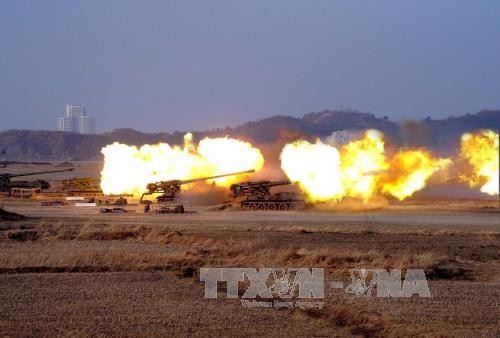(VOVworld) - The situation on the Korean peninsula grew even tenser after the US and South Korea on Wednesday moved parts of the Terminal High Altitude Area Defense (THAAD) missile defense system to its designated site in Seongju County in central South Korea and the US conducted live fire drills with South Korea and Japan.
 |
North Korea's 681 artillery unit trained at a secret site. (Photo posted on KCNA 12/2/2009/ EPA/VNA)
|
Tension on the Korean peninsula escalated after North Korea announced it will soon conduct its 6th nuclear test and more ballistic missile tests. In response, the US deployed warships and submarines to the Korean peninsula, affirmed its commitment to protect Japan and South Korea, and opened the possibility of punishments, including economic sanctions and military action against North Korea.
Transporting THAAD devices to the deployment site
On Wednesday six trailer trucks transported the main components of THAAD, including mobile launch platforms and radar, to Seongju County. The US army is installing the final pieces of the high-altitude missile system to prepare for a threatened nuclear missile attack by North Korea. South Korea’s Defense Ministry has confirmed it has begun to fully deploying THAAD. Admiral Harry Harris of the US Pacific Command said the North Korean leader's "strategic capabilities are not yet an existential threat to the US. But when he gains the capability to match his rhetoric, at that point, the US will wake up to a new world.
The US and South Korea transported the THAAD components to their deployment site despite strong protests from locals and criticism from presidential candidates. A spokesperson for candidate Moon Jae-in of the Democratic Party said the THAAD deployment has ignored the people’s wishes and has also ignored required procedures. A spokesperson for candidate Ahn Cheol-soo of the People’s Party demanded that the Defense Ministry abide by South Korean law and bilateral agreements.
More military drills
While North Korea conducted massive artillery drills, the US conducted military drills with South Korea and Japan.
On Tuesday, South Korea and the US staged a live-fire drill in the Yellow Sea that involved the Korean destroyer Wanggeon and the USS E.Meyer. Another joint military drill in the Sea of Japan is planned later this month, that will involve the nuclear-powered aircraft carrier USS Carl Vinson.
On its way to the Korean Peninsula, if the weather is favorable, the Carl Vinson will conduct a military drill with Japan’s Air Self-Defense Force. They will organize in-the-air training and information sharing to improve their communications capability. The aircraft carrier already conducted a two-day drill with two Japanese destroyers in the Philippine Sea, reroute to the Korean peninsula.
North Korea’s Ministry of Foreign Affairs has accused the US of pushing the situation to the brink of nuclear war. Prior to a UN Security Council session on North Korea’s nuclear and missile programs on Friday, North Korea said that if there is a war on the Korean Peninsula, the US must take full responsibility.
Together with increased military actions, the US has said President Trump wants to tighten sanctions to pressure North Korea to abandon its nuclear and missile programs. Washington said it will continue to pursue diplomatic measures to bring Pyongyang back to the negotiating table.